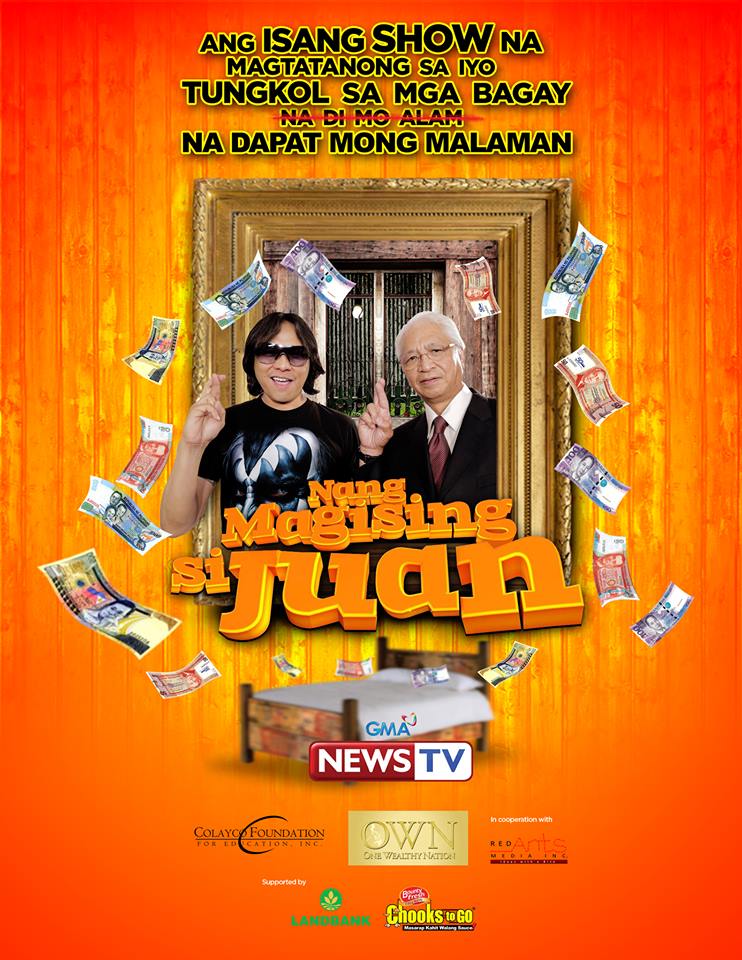Airing on GMA News TV, Sundays 8:00AM beginning May 18, 2014
Produced by Colayco Foundation for Education, Inc. in cooperation with Red Ants Media. Supported by KsKCoop, Landbank of the Philippines, Chooks To Go, AurumOne Makati, and many more.

“Nang Magising Si Juan” is not your ordinary financial literacy program. This comedy-reality show is set to educate, relate, entertain and inspire by tackling common money issues every Filipino can relate to. This show not only teaches practical and doable financial management, but also promotes positive values and corrects wrong mindsets in and beyond the topic of money.
The driving point of the whole show is this: Beyond the how-to, it’s the essence, the core principles and the right attitude applied that can truly make a difference.
To further emphasize the importance of practical application of principles, this show features a social experiment on the show’s main character. The goal is to enlighten him and improve his financial situation. As a relatable character, the show aims to inspire the audience and send them the message, “Kung kaya niya, kakayanin niyo rin.”
“Nang Magising si Juan” is named as such because it directly reflects the perceptions, attitudes and habits of Filipinos and tries to serve as a wake-up call. On the other side of the coin, this show also reinforces the value of getting up and actually doing something to achieve one’s personal goals and dreams.
The main character is Ariel Villasanta, a real-life comedian who got his share of the limelight and extravagant living but is now struggling with debt. Refusing to come to terms with reality, he projects a flamboyant image and lives in a big house, but with no electricity. (To which he puts a signage on his gate for all his neighbors to see: “Support Earth Hour Every day!”)
His anxiety about his finances urges him to talk to the financial guru in the show he writes in, “Feeling Close with FJC”. This show-within-a-show is a parody of a typical business & finance show: stiff sofas, big potted plants, tacky background design and lounge music playing. This will be used as a platform to deliver the financial principles and techniques that Ariel will process throughout the show. The show’s star, real-life award-winning financial guru Mr. Colayco, a wise but brutally frank man, corrects Ariel’s wrong perspectives and pushes him to change with challenging questions.
Along with other characters (played by non-actors), Ariel encounters different financial issues that plague the common Pinoy. Mr. Colayco gives practical advice and techniques in layman’s terms. Ariel puts some of it to practice, some he willfully ignores to do his own “diskarte”(not without amusing consequences of course).
In his journey to financial literacy and freedom, Ariel discovers that there’s more to managing wealth than just accumulating money and becoming rich. He also learns the values of self-discipline, hard work and even self-worth and generosity that improve his quality of life in a way more than money can.
Nang Magising Si Juan is open for commercial advertisements for more information email partnerships@colaycofoundation.com

 many units of products you need to sell at a given unit price) so that you will be able to sustain your business. Break-even does not mean you are losing money but it also does not mean that you are making money. If your sales are below your break-even, you will be incurring losses and if it is higher, your will be making money.
many units of products you need to sell at a given unit price) so that you will be able to sustain your business. Break-even does not mean you are losing money but it also does not mean that you are making money. If your sales are below your break-even, you will be incurring losses and if it is higher, your will be making money.

